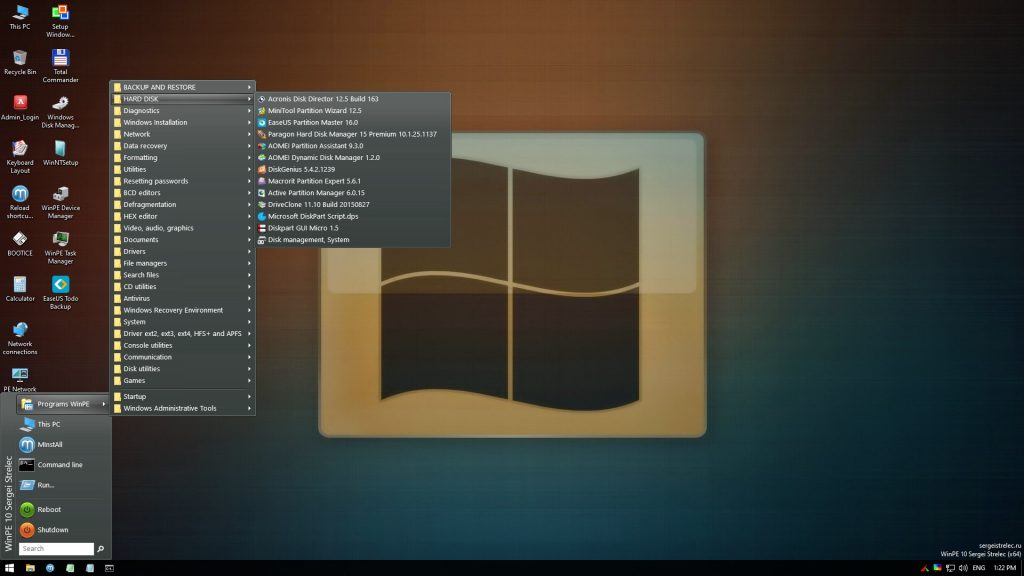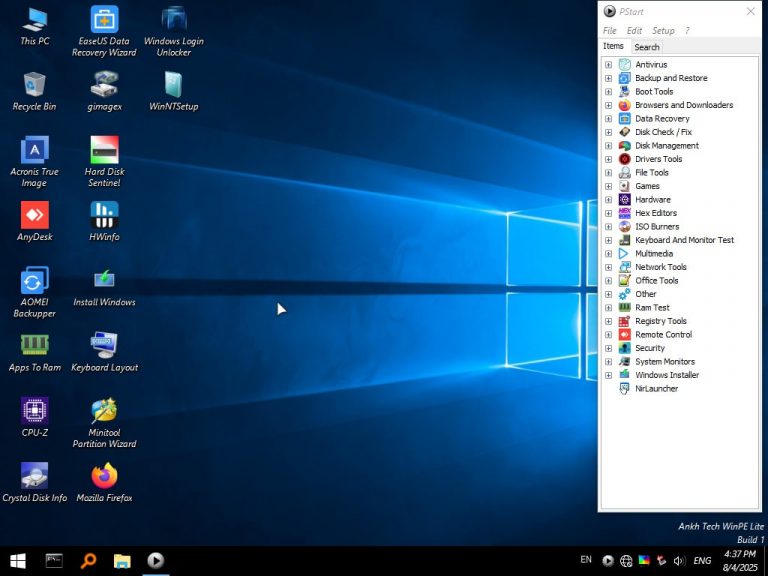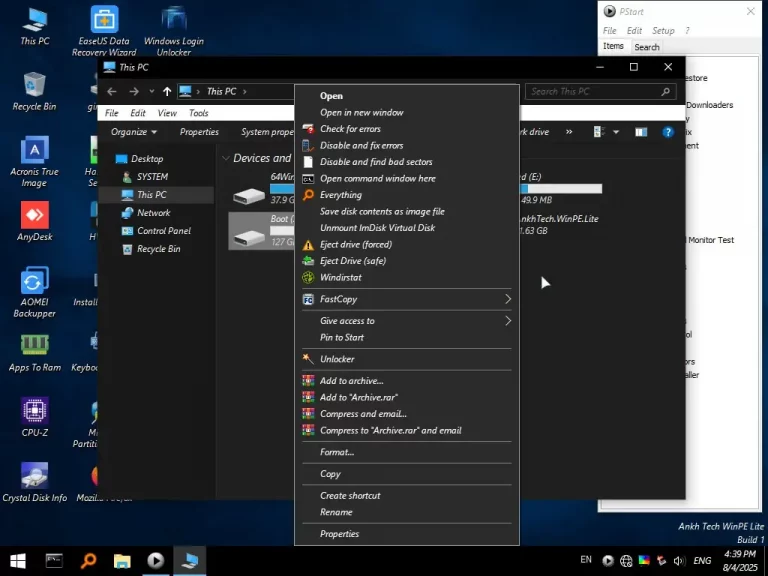WinPE (Windows Preinstallation Environment) is a minimal Windows-based environment that can boot from USB, CD/DVD, or other media. It is often used for system maintenance tasks: partitioning disks, imaging and restoring, diagnostics, data recovery, and installing or repairing operating systems.

WinPE 11-10-8 Sergei Strelec is a widely known custom all-in-one WinPE distribution built by Sergei Strelec. It includes multiple “flavors” (x86, x64, native x86) to support a variety of hardware and older systems. The naming “11-10-8” means it supports WinPE versions for Windows 11, Windows 10, and Windows 8. The “Native x86” mode is a special minimal kernel mode intended for very limited hardware or low footprint usage.
This distribution bundles many tools, drivers, utilities, and customization to make it a powerful rescue / repair / deployment environment.
Editions / Variants
The main variants in the Sergei Strelec WinPE build include:
- x64 WinPE (for 64-bit systems, for Windows 11 / 10)
- x86 WinPE (32-bit environment, to support older hardware or USB boot compatibility)
- Native x86 mode — a minimal mode where the kernel loads minimal GUI or no GUI and operates with script logic to find and load more components. The “native” mode is optimized for lower memory, older CPUs, or slower boot media. (In fact, in the version notes, Strelec mentions advantages such as lower memory consumption, reduced CPU requirements, and faster load on slow USB media).
These variants offer flexibility so the user can boot on older PCs, newer hardware, or in constrained environments.
Key Features & Capabilities
Here are the capabilities and features commonly included in recent versions of Strelec’s WinPE builds:
1. Broad Tool / Application Suite
One of the standout features is the large collection of built-in utilities across many categories:
- Disk / Partition / Imaging / Backup / Restore — e.g. Acronis Disk Director, Acronis True Image, Paragon tools, Macrium Reflect, EaseUS, Active Disk Image, Ghost, etc.
- Diagnostics Tools — HDD/SSD testing (e.g. HD Tune, Check Disk GUI, SMART analysis)
- Network / Internet Utilities — networking tools (Penetwork), drive mapping, network protocol support, perhaps web tools or file transfer utilities.
- File management / recovery / data tools — for copying, recovering, scanning partitions, file browsing.
- Windows installation tools — an installer front end (“78Setup” in the root) where you can mount or select Windows install images (WIM / ESD) or Windows ISO images, and then deploy them.
- Antivirus / Rescue / Bootable Linux ISOs — ability to include or mount rescue media such as Kaspersky Rescue Disk, Dr.Web LiveDisk, etc.
- Support for adding Linux ISO images — the build allows mounting or including Linux rescue ISOs inside the environment.
Thus, it is a multi-purpose environment, useful for many IT tasks without needing to boot multiple separate media.
2. Multi-Kernel / Multi-Version Composition
The build is composed of multiple WinPE versions within the same ISO:
- WinPE11 x64
- WinPE10 x64
- WinPE10 x86
- WinPE8 x86
- WinPE8 Native x86
This composition allows it to boot in different modes depending on the hardware or desired compatibility.
3. UEFI & Legacy Boot, Partition Scheme Compatibility
The build supports UEFI booting (for newer hardware) and likely supports legacy BIOS / MBR systems, making it widely compatible. It supports both MBR and GPT partition schemes. Portables
4. Native Mode Operation
The Native x86 mode is a specialized mode that Strelec describes as:
- Faster loading on slow USB media (especially USB 1.x).
- Lower memory consumption (for Strelec’s build, about 250 MB less)
- Reduced CPU requirements (patched kernel, with NX-bit disabled)
However, there are trade-offs:
- Binding to the media (if you extract, the PC may “hang”)
- Slower core operations because more is loaded from slower media instead of RAM disk
- Some advanced CPU / multi-core / PAE features are disabled in native mode to maintain compatibility.
For modern PCs, Strelec himself suggests normal startup is better, while native mode is for constrained hardware.
5. Custom Boot & Menu Logic
- Search & Start Windows menu item — attempts to detect and load a Windows install by looking for
winload.exe(useful when MBR / BCD / boot files are broken). - The ISO can carry a
_WINfolder containing install.wim / install.esd or even Windows ISOs; the menu will list them for installation. - The ISO is designed to run from USB, DVD, or from within boot frameworks like Ventoy or Easy2Boot.
6. Kernel Adjustments & Stability
In the recent version (2025.09.07), the Strelec build notes that the WinPE 11 kernel has been downgraded from version 22621.4387 to 22621.1483, because the older version was found more stable in WinPE contexts.This suggests the author is selecting kernel revisions not just for feature parity, but for reliability in a minimal environment.
Other “minor changes” are also mentioned in that version, though specifics aren’t fully enumerated.
7. Memory / Resource Optimization
Strelec’s builds often aim to reduce memory usage, strip unnecessary services, and disable features not needed in a WinPE context. In the version notes, the native mode is especially for optimized memory usage.
Also, in updates the build may remove or disable certain modules or services that are not needed for rescue mode, to reduce boot size and overhead.
What Has Been Removed, Disabled or Altered (vs. Full Windows)
Because Strelec’s WinPE is a minimal and specialized environment, many full Windows features are naturally not present. Over successive versions, some additional removals or optimizations are applied. Here is what is removed, disabled, or altered:
- Full Windows GUI / Shell features
The full graphical shell of Windows (Explorer, Start menu, many UI components) is stripped down or replaced by minimal desktop environment. Many UI features in full Windows are unnecessary in PE. - Services / Background Tasks Removed or Disabled
Many system services (print spooler, telemetry, update agents, Windows Update, indexing, etc.) are disabled or omitted. The environment focuses solely on rescue / maintenance tasks. - Driver bloat reduction
Only essential drivers (disk, USB, network, common storage, etc.) are included; rarely used or proprietary drivers may be omitted to keep the image lean. - Kernel features trimmed for native mode
In native x86 mode, multi-core support, PAE, or NX-bit are disabled. - Non-rescue tools / consumer apps omitted
Applications or services that are not directly useful for maintenance or recovery are not included (e.g., entertainment apps, many UWP features). - Boot / recovery features trimmed
Some full Windows recovery or reset features simply cannot work in WinPE, so such components are not included.
In sum, Strelec’s WinPE distribution is carefully curated to include necessary tools, and remove or disable everything else that is not beneficial in a rescue environment.
New / Changed in Latest Versions
From the public notes of the latest versions (e.g. 2025.09.07 build), here are some observable changes or refinements:
- Kernel version adjustment — the WinPE 11 kernel version was downgraded for stability in PE context (22621.4387 → 22621.1483).
- “Minor changes” — while not fully disclosed, the author mentions “other minor changes” besides the kernel change.
- Possibly updated internal utilities or newer versions of bundled tools (though the public description doesn’t list all).
- Optimizations for boot, compatibility, and component inclusion may have been refined.
Because Sergei Strelec’s releases do not always publish a full detailed changelog, many changes are inferred or visible by comparing builds.
Strengths, Limitations & Risks
Strengths
- Comprehensive & versatile — Many tools, utilities, and functionalities packed in a single ISO.
- Multi-mode support — Ability to boot in x86, x64, or native mode depending on hardware or need.
- Good hardware compatibility — UEFI and legacy mode support, MBR/GPT compatibility, broad driver support.
- Optimized for rescue / maintenance — Because it’s a PE environment, it’s lean and focused on utility tasks.
- Active updates / refinement — The build is maintained and refined over time (kernel adjustments, tool updates).
Limitations & Risks
- No full Windows environment — It is a PE environment, not a full OS, so many advanced OS-level features are absent.
- Potential for antivirus false positives or flagged components — Some users report that parts of Sergei Strelec’s build are flagged by antivirus engines, possibly due to included utilities or modification.
- Legality / distribution concerns — There is debate in forums about licensing, inclusion of cracked or unauthorized software, or components that may violate copyright.
- Hardware or boot compatibility failures — As with any custom PE, some hardware or boot configurations may not boot properly, or certain drivers may fail. Some users report failures on particular laptops.
- Stability tradeoffs — Some tools or modes (particularly native mode) have compromises (slower core operations, kernel limitations).
- Lack of official support — Being a third-party PE build, there’s no official Microsoft support or guaranteed critical updates.
Use Cases & Best Practices
Ideal Use Cases
- System recovery / repair / diagnostics — recovering data, fixing boot issues, scanning disks, etc.
- Mass deployment or imaging tasks — deploying Windows images or restoring images across multiple machines.
- Hardware diagnostics or testing — checking drives, memory, temperature, etc.
- Multi-boot USB toolset — combining many utilities in one USB to carry to client machines.
Best Practices
- Always test on non-critical systems first to verify compatibility.
- Use the variant (x64, x86, native) best suited for the target hardware.
- Keep a copy of original ISOs, avoid modifying the core unless you know what you’re doing.
- If boot fails, try alternate boot mode (UEFI vs legacy) or variant image.
- Be aware of antivirus flags and false positives — some included tools may trigger alerts.
- Use safe boot media (prefer USB 3.0 or faster) to reduce I/O delays.
- When possible, backup your critical data before relying solely on this environment.
Download WinPE 11-10-8 Sergei Strelec (x86/x64/Native x86) English
Password for archive: strelec
Update patch from version WinPE11_10_8_Sergei_Strelec_x86_x64_2025.02.17_English
Password for archive: strelec


